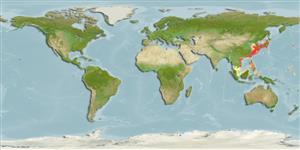Common names from other countries
Environment: milieu / climate zone / depth range / distribution range
Ecologie
marien demersaal; diepte 25 - 615 m (Ref. 11230). Tropical
Northwest Pacific: southern Hokkaido, Japan southward to the South China Sea.
Grootte / Gewicht / Leeftijd
Maturity: Lm ? range ? - ? cm
Max length : 40.0 cm TL mannelijk / geslacht onbekend; (Ref. 559); max. gepubliceerd gewicht: 950.00 g (Ref. 40637)
Dorsale zachte stralen (totaal): 15-17; Anale zachte stralen: 15 - 17. Lower half of the inner pectoral fin with scattered numerous pale spots (bluish in life, white or pale in preserved specimens); black blotch appears occasionally on lower inner part of pectoral fin.
Found in the tropical to warm temperate areas (Ref. 9771), in sandy or sandy mud bottom (Ref. 11230).
Levenscyclus en paargedrag
Maturiteit | Voortplanting | Paaien | Eieren | Fecunditeit | Larven
Richards, W.J., 1999. Triglidae. Gurnards, sea robins, armored gurnards, and armored sea robins. p. 2359-2363. In K.E. Carpenter and V.H. Niem (eds.) FAO species identification guide for fishery purposes. The living marine resources of the WCP. Vol. 4. Bony fishes part 2 (Mugilidae to Carangidae). FAO, Rome. (Ref. 9771)
Status op de Rode Lijst van het IUCN (Ref. 130435)
CITES (Ref. 128078)
Not Evaluated
Gevaar voor de mens
Harmless
Gebruik door de mens
Visserij: commercieel
Meer informatie
Lokale namenSynoniemenMetabolismePredatorenEcotoxicologieVoortplantingMaturiteitPaaienFecunditeitEierenOntwikkeling van de eieren
ReferentiesAquacultuurAquacultuurprofielKweeklijnenGeneticaElectrophoresesErfelijkheidZiektesVerwerkingMassaconversie
Tools
Speciale rapporten
Download XML
Internetbronnen
Estimates based on models
Preferred temperature (Ref.
115969): 6.1 - 23.1, mean 17.9 (based on 261 cells).
Fylogenetische diversiteitsindex (Ref.
82804): PD
50 = 0.5010 [Uniqueness, from 0.5 = low to 2.0 = high].
Bayesian length-weight: a=0.00692 (0.00459 - 0.01043), b=3.06 (2.94 - 3.18), in cm Total Length, based on LWR estimates for this species & (Sub)family-body (Ref.
93245).
Trofisch niveau (Ref.
69278): 3.9 ±0.7 se; based on diet studies.
Weerstandsvermogen (Ref.
120179): Gemiddeld, minimale populatieverdubbelingstijd 1,4-4,4 jaar (Preliminary K or Fecundity.).
Fishing Vulnerability (Ref.
59153): Low to moderate vulnerability (30 of 100).
